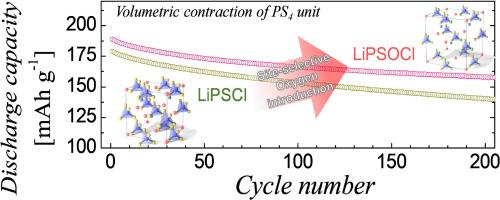位置选择性氧引入对硫化物基银柱石结构稳定性、水分稳定性和电池性能的影响
IF 20.2
1区 材料科学
Q1 CHEMISTRY, PHYSICAL
引用次数: 0
摘要
全固态电池(assb)是一种以硫化物为基础的固体电解质,作为下一代二次电池而备受关注。然而,对于ASSB商业化至关重要的硫化氢气体生成问题仍未得到解决。虽然氧气的引入提高了水分稳定性,但它会导致离子电导率和电池性能的显著下降,而水分稳定背后的机制尚不清楚。在这里,我们研究了硫化物基银柱石中PS4单元的Wyckoff 16e位点选择性氧取代的作用,它诱导结构稳定,以及它对水分稳定性和电池性能的影响。通过合成一种新型的富含卤化物的化合物Li5.33PS4.27O0.12Cl1.55 (HR-LiPSOCl),在水分稳定性方面有了很大的改善,放电容量高达212 mAh g⁻¹,并且在200次循环中保持85%的容量。制备了28mah cm-2 (215 mg cm-2)的超高面容量电池和870 Wh -1能量密度的袋状电池来评价HR-LiPSOCl的性能。此外,还阐明了氧在银柱石中的位点选择性及其稳定性提高的机理。这项研究旨在提供创新的见解,以一种简单有效的方式改善固体电解质的性能,同时使用一种组合物,最大限度地减少昂贵的Li₂S的数量,确保成本效益。了解氧取代机理及其对水分稳定的贡献将进一步推动固体电解质的商业化。本文章由计算机程序翻译,如有差异,请以英文原文为准。


Impacts of site-selective oxygen introduction on structural stabilization, moisture stability, and battery performance in sulfide-based argyrodite
With sulfide-based solid electrolytes (SEs), all-solid-state batteries (ASSBs) have gained attention as next-generation secondary batteries. However, the issue of hydrogen sulfide gas generation, which is critical for ASSB commercialization, remains unresolved. While the introduction of oxygen improves moisture stability, it results in significant degradation in ionic conductivity and cell performance, and the mechanism behind moisture stabilization is unknown. Here, we investigate the effect of site-selective oxygen substitution at the Wyckoff 16e site of a PS4 unit in a sulfide-based argyrodite, which induces structural stabilization, and its influence on moisture stability and cell performance. By synthesizing a novel halide-rich composition-based Li5.33PS4.27O0.12Cl1.55 (HR-LiPSOCl), substantial improvements in moisture stability, a high discharge capacity of 212 mAh g−1, and 85 % capacity retention over 200 cycles are demonstrated. An ultra-high areal capacity cell of 28 mAh cm-2 (215 mg cm-2) and a pouch cell with an energy density of 870 Wh L-1 are fabricated to evaluate the performance of HR-LiPSOCl. Additionally, the site-selective characteristic of oxygen in argyrodite and the mechanism behind the improved stability are clarified. This study aims to provide innovative insights into improving the performance of solid electrolytes in a simple and effective manner while using a composition that minimizes the amount of expensive Li₂S, ensuring cost-efficiency. Understanding the oxygen substitution mechanism and its contribution to moisture stabilization will further advance the commercialization of solid electrolytes.
求助全文
通过发布文献求助,成功后即可免费获取论文全文。
去求助
来源期刊

Energy Storage Materials
Materials Science-General Materials Science
CiteScore
33.00
自引率
5.90%
发文量
652
审稿时长
27 days
期刊介绍:
Energy Storage Materials is a global interdisciplinary journal dedicated to sharing scientific and technological advancements in materials and devices for advanced energy storage and related energy conversion, such as in metal-O2 batteries. The journal features comprehensive research articles, including full papers and short communications, as well as authoritative feature articles and reviews by leading experts in the field.
Energy Storage Materials covers a wide range of topics, including the synthesis, fabrication, structure, properties, performance, and technological applications of energy storage materials. Additionally, the journal explores strategies, policies, and developments in the field of energy storage materials and devices for sustainable energy.
Published papers are selected based on their scientific and technological significance, their ability to provide valuable new knowledge, and their relevance to the international research community.
 求助内容:
求助内容: 应助结果提醒方式:
应助结果提醒方式:


